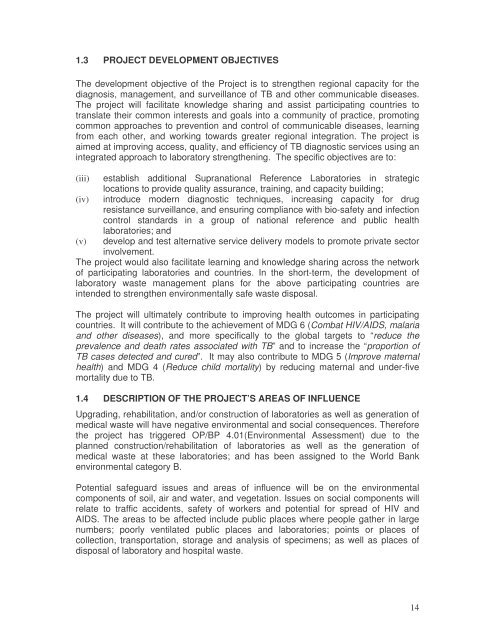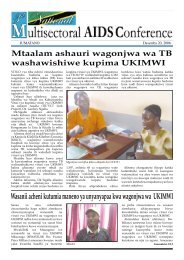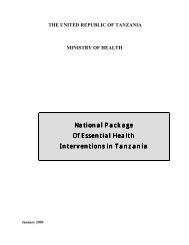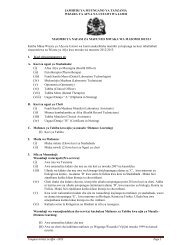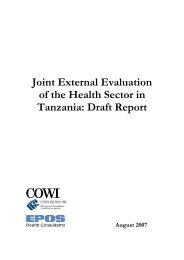Environmental and Social Management Framework for Tanzania ...
Environmental and Social Management Framework for Tanzania ...
Environmental and Social Management Framework for Tanzania ...
Create successful ePaper yourself
Turn your PDF publications into a flip-book with our unique Google optimized e-Paper software.
1.3 PROJECT DEVELOPMENT OBJECTIVES<br />
The development objective of the Project is to strengthen regional capacity <strong>for</strong> the<br />
diagnosis, management, <strong>and</strong> surveillance of TB <strong>and</strong> other communicable diseases.<br />
The project will facilitate knowledge sharing <strong>and</strong> assist participating countries to<br />
translate their common interests <strong>and</strong> goals into a community of practice, promoting<br />
common approaches to prevention <strong>and</strong> control of communicable diseases, learning<br />
from each other, <strong>and</strong> working towards greater regional integration. The project is<br />
aimed at improving access, quality, <strong>and</strong> efficiency of TB diagnostic services using an<br />
integrated approach to laboratory strengthening. The specific objectives are to:<br />
(iii) establish additional Supranational Reference Laboratories in strategic<br />
locations to provide quality assurance, training, <strong>and</strong> capacity building;<br />
(iv) introduce modern diagnostic techniques, increasing capacity <strong>for</strong> drug<br />
resistance surveillance, <strong>and</strong> ensuring compliance with bio-safety <strong>and</strong> infection<br />
control st<strong>and</strong>ards in a group of national reference <strong>and</strong> public health<br />
laboratories; <strong>and</strong><br />
(v) develop <strong>and</strong> test alternative service delivery models to promote private sector<br />
involvement.<br />
The project would also facilitate learning <strong>and</strong> knowledge sharing across the network<br />
of participating laboratories <strong>and</strong> countries. In the short-term, the development of<br />
laboratory waste management plans <strong>for</strong> the above participating countries are<br />
intended to strengthen environmentally safe waste disposal.<br />
The project will ultimately contribute to improving health outcomes in participating<br />
countries. It will contribute to the achievement of MDG 6 (Combat HIV/AIDS, malaria<br />
<strong>and</strong> other diseases), <strong>and</strong> more specifically to the global targets to “reduce the<br />
prevalence <strong>and</strong> death rates associated with TB” <strong>and</strong> to increase the “proportion of<br />
TB cases detected <strong>and</strong> cured”. It may also contribute to MDG 5 (Improve maternal<br />
health) <strong>and</strong> MDG 4 (Reduce child mortality) by reducing maternal <strong>and</strong> under-five<br />
mortality due to TB.<br />
1.4 DESCRIPTION OF THE PROJECT’S AREAS OF INFLUENCE<br />
Upgrading, rehabilitation, <strong>and</strong>/or construction of laboratories as well as generation of<br />
medical waste will have negative environmental <strong>and</strong> social consequences. There<strong>for</strong>e<br />
the project has triggered OP/BP 4.01(<strong>Environmental</strong> Assessment) due to the<br />
planned construction/rehabilitation of laboratories as well as the generation of<br />
medical waste at these laboratories; <strong>and</strong> has been assigned to the World Bank<br />
environmental category B.<br />
Potential safeguard issues <strong>and</strong> areas of influence will be on the environmental<br />
components of soil, air <strong>and</strong> water, <strong>and</strong> vegetation. Issues on social components will<br />
relate to traffic accidents, safety of workers <strong>and</strong> potential <strong>for</strong> spread of HIV <strong>and</strong><br />
AIDS. The areas to be affected include public places where people gather in large<br />
numbers; poorly ventilated public places <strong>and</strong> laboratories; points or places of<br />
collection, transportation, storage <strong>and</strong> analysis of specimens; as well as places of<br />
disposal of laboratory <strong>and</strong> hospital waste.<br />
14


